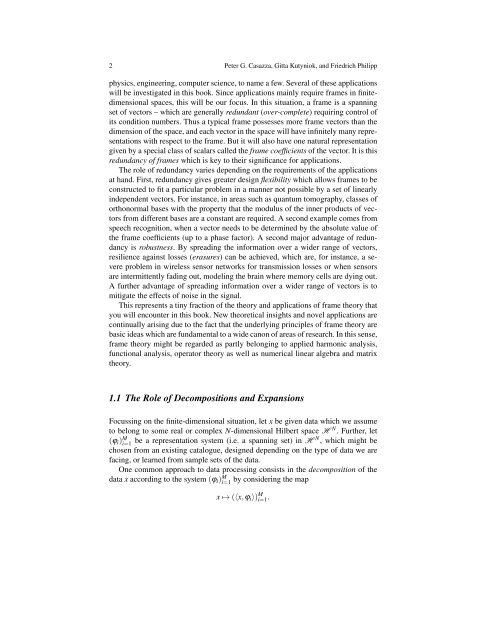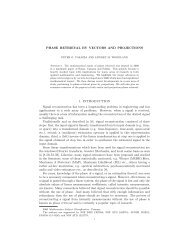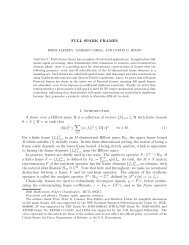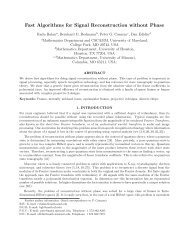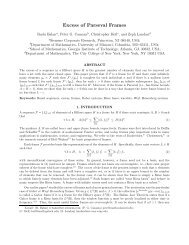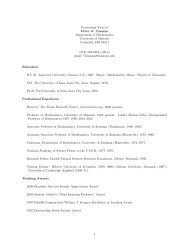Introduction to Finite Frame Theory - Frame Research Center
Introduction to Finite Frame Theory - Frame Research Center
Introduction to Finite Frame Theory - Frame Research Center
You also want an ePaper? Increase the reach of your titles
YUMPU automatically turns print PDFs into web optimized ePapers that Google loves.
2 Peter G. Casazza, Gitta Kutyniok, and Friedrich Philipp<br />
physics, engineering, computer science, <strong>to</strong> name a few. Several of these applications<br />
will be investigated in this book. Since applications mainly require frames in finitedimensional<br />
spaces, this will be our focus. In this situation, a frame is a spanning<br />
set of vec<strong>to</strong>rs – which are generally redundant (over-complete) requiring control of<br />
its condition numbers. Thus a typical frame possesses more frame vec<strong>to</strong>rs than the<br />
dimension of the space, and each vec<strong>to</strong>r in the space will have infinitely many representations<br />
with respect <strong>to</strong> the frame. But it will also have one natural representation<br />
given by a special class of scalars called the frame coefficients of the vec<strong>to</strong>r. It is this<br />
redundancy of frames which is key <strong>to</strong> their significance for applications.<br />
The role of redundancy varies depending on the requirements of the applications<br />
at hand. First, redundancy gives greater design flexibility which allows frames <strong>to</strong> be<br />
constructed <strong>to</strong> fit a particular problem in a manner not possible by a set of linearly<br />
independent vec<strong>to</strong>rs. For instance, in areas such as quantum <strong>to</strong>mography, classes of<br />
orthonormal bases with the property that the modulus of the inner products of vec<strong>to</strong>rs<br />
from different bases are a constant are required. A second example comes from<br />
speech recognition, when a vec<strong>to</strong>r needs <strong>to</strong> be determined by the absolute value of<br />
the frame coefficients (up <strong>to</strong> a phase fac<strong>to</strong>r). A second major advantage of redundancy<br />
is robustness. By spreading the information over a wider range of vec<strong>to</strong>rs,<br />
resilience against losses (erasures) can be achieved, which are, for instance, a severe<br />
problem in wireless sensor networks for transmission losses or when sensors<br />
are intermittently fading out, modeling the brain where memory cells are dying out.<br />
A further advantage of spreading information over a wider range of vec<strong>to</strong>rs is <strong>to</strong><br />
mitigate the effects of noise in the signal.<br />
This represents a tiny fraction of the theory and applications of frame theory that<br />
you will encounter in this book. New theoretical insights and novel applications are<br />
continually arising due <strong>to</strong> the fact that the underlying principles of frame theory are<br />
basic ideas which are fundamental <strong>to</strong> a wide canon of areas of research. In this sense,<br />
frame theory might be regarded as partly belonging <strong>to</strong> applied harmonic analysis,<br />
functional analysis, opera<strong>to</strong>r theory as well as numerical linear algebra and matrix<br />
theory.<br />
1.1 The Role of Decompositions and Expansions<br />
Focussing on the finite-dimensional situation, let x be given data which we assume<br />
<strong>to</strong> belong <strong>to</strong> some real or complex N-dimensional Hilbert space H N . Further, let<br />
(ϕ i ) M i=1 be a representation system (i.e. a spanning set) in H N , which might be<br />
chosen from an existing catalogue, designed depending on the type of data we are<br />
facing, or learned from sample sets of the data.<br />
One common approach <strong>to</strong> data processing consists in the decomposition of the<br />
data x according <strong>to</strong> the system (ϕ i ) M i=1 by considering the map<br />
x ↦→ (〈x,ϕ i 〉) M i=1.


